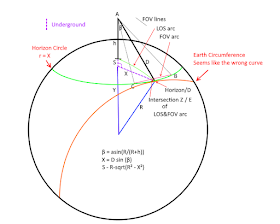I've been vaguely aware of this for a while but I haven't really had a chance to go look at it before now:
I gotta say, huge thanks to Rob Skiba for proving the Earth is a globe -- so I'm going to keep this one fairly short and simple.
It's a shame that they didn't use something like the Canon 11mm lens on a real camera (126° FOV!) -- but we will have to make do with their tiny 47° Field of View 7.2mm GoPro "non-fish-eye lens".
So around 1:48:30 in the video we are treated with the following view from 95,733 feet up -- according to Rob Skiba and friends:
 |
| Figure 1. Rob Skiba YouTube video circa 1:48:30 |
There is very clearly about 10 pixels of what I call the 'apparent horizon Sagitta'. The horizon is curved, it matches what we expect on a Globe of approximately 3959 miles radius.
Flat Earth is DONE... Right? (LOL if you think Flat Earthers will believe their OWN evidence you are INSANE!)
But WHY would we expect this on the Globe?
If you recall back from my post describing what the Horizon IS, it is a circle formed where your line-of-sight hits tangent to the Spheroid of the Earth -- aside from terrain differences (almost irrelevant from this high up unless you are looking at high mountains) it is roughly equidistant from you all the way around.
This example figure would be a height of roughly a thousand miles up and the Green Circle would be the horizon. If the Earth were smooth you wouldn't be able to see any of the Earth past this circle (but mountains and tall buildings can stick up past it).
So the Apparent Sagitta here is a small section of this arc being viewed nearly on edge (a true Sagitta is the arc formed by a chord on a circle, I call this "Apparent Sagitta" because we're viewing it sharply rotated).
You can also see how this works in Walter Bislin's Horizon rendering tool, which will we revisit below.
 |
| Figure 2. Horizon geometry |
Since your height here in a balloon, even at 100k feet, is VERY SMALL. For comparison here is the view from the ISS, 400 kilometers up.
 |
| Figure 3. Horizon to Scale for ISS (4x higher than this balloon) |
Here is what we get from Walter Bislin's site for 29179 meters and a 47° field of view:
 |
| Figure 4. Walter Bislin's Horizon Rendering |
And here is the overlay with Rob Skiba's video -- an incredible match for all that "fake Globe math"?
 |
| Figure 5. Overlay of Rob Skiba video with Walter Bislin's horizon |
Conclusion:
So this is pretty much EXACTLY the amount of horizon droop (or Apparent Sagitta) we would expect on the Globe.
See Also:
Sly Sparkane's analysis video, which covers Skiba's first Balloon launch which they apparently lost.
Teme Wilson also did an Earth rendering in Blender to compare the horizon:
No comments:
Post a Comment
Note: Only a member of this blog may post a comment.